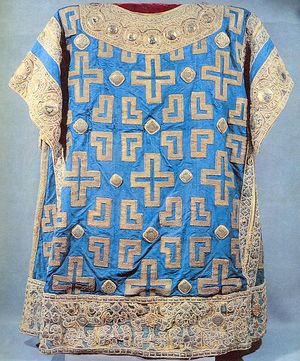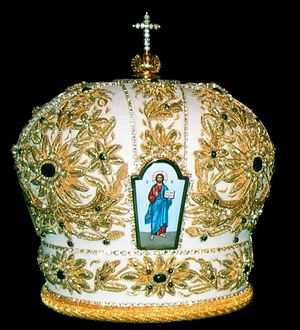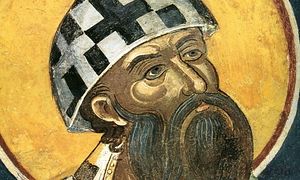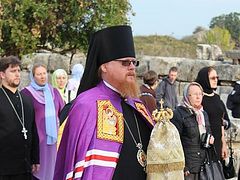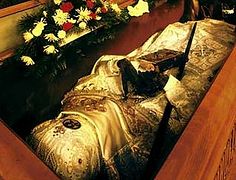The Sakkos
The sakkos, from the Hebrew sakk meaning “sackcloth” was part of the emperor’s wardrobe in Byzantium. This garment had no sleeves and was donned over the head and buttoned on the sides. In the eleventh and twelfth centuries, emperors began to give sakkos as a gift to patriarchs in Constantinople. Patriarchs often wore the sakkos only on Christmas, Pascha, and Pentecost. Several bishops began to wear the sakkos in the fourteenth and fifteenth centuries, but the phelonion continued to be the traditional hierarchical vestment.[1] By this time the sakkos had a acquired short sleeves. Saint Gregory Palamas, the archbishop of Thessalonica, is depicted on icons wearing the omophorion and sakkos with short sleeves. Many Greek bishops began to wear the sakkos in the sixteenth century. By that time the sleeves of the sakkos had become longer, yet shorter than the sleeves of the sticharion.
It is difficult to determine exactly when bells first appeared on the sakkos. It is evident, however that they serve as a reminder of the bells worn by Aaron on his robe, that their sound “will be heard when Aaron is serving as a priest, entering and leaving the holy place before the Lord” (Ex. 28:30). Bells produce a ringing sound whenever the bishop moves around the church.
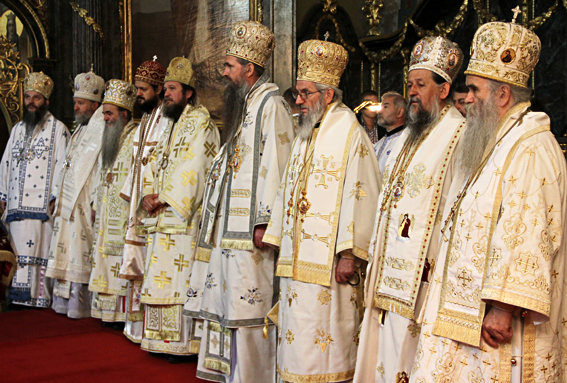 Serbian Bishops in sakkos and mitre.
Serbian Bishops in sakkos and mitre. The sakkos first appeared in Russia no later than the fourteenth century as a liturgical vestment of Moscow’s metropolitans. The sakkos of Metropolitan Peter (1308-1326) is preserved to this day. It was sewn in 1322 from light-blue satin material on which crosses in circles are woven with gold. Both “large” and “small” sakkos survives from Metropolitan Photius (1409-1431). They are distinguished by their unusual richness of surface embroidery. After the establishment of the patriarchate in 1589, the sakkos became the vestment of Moscow’s patriarchs. The sakkos was worn in the seventeenth century by metropolitans and some archbishops. In 1705 it was established that all hierarchs of the Russian Church must wear the sakkos.
The Mitre
The mitre was not an attribute of the hierarch’s vestments during the earliest days. The scholar Aleksei Dmitrievsky believes “this adornment for the bishop’s head was made an article of their rank fairly recently”. He wrote that “nothing but a complete silence is maintained regarding the mitre in all ancient and later services for consecrating not only a bishop, but also a metropolitan and even a patriarch, which includes Greek, south-Slavic, and also our Slavonic-Russian service books, hand-written as well as printed and even those used in the practice of serving in the East and in Russia”.[2]
Although it is a relatively new phenomenon that the mitre is attributed to every bishop, the use of the mitre by individual hierarchs reaches back to deep antiquity. The origin of the mitre is found in the turban, the liturgical headdress of the Old Testament high priests. Saint John Chrysostom refers to the mitre is this very context.[3] There are numerous testimonies of the mitre as an attribute of the Alexandrian patriarchs. Saints Athanasius and Cyril of Alexandria are often depicted in ancient frescoes wearing white hats having black crosses. It was the custom of the Alexandrian patriarchs to wear such mitres. During the time of Saint Simeon of Thessalonica (fifteenth century), many other bishops in the East wore mitres, but traditionally it was still considered an attribute primarily of the Alexandrian patriarch. To the question, “Why do bishops and priests, with the exception of the Alexandrian patriarch, serve with uncovered heads and why is it better to serve with an uncovered head,” Saint Simeon of Thessalonica answered:
All eastern hierarchs and priests, with the exception of the Alexandrian (patriarch), conduct the sacred serving with uncovered heads… But, perhaps, somebody will ask whether it is not irreverent that the Alexandrian patriarch covers his head with the sacred covering (Gr. hieron epikalymma) as do countless others in accordance with ancient tradition? I do not ask this, for those who act in this way (and it serves as a justification) act according to the most ancient, or more accurately—“most lawful”[4]—tradition. Actually, the “lawful”[5] high priest wore on his head a turban (Gr. kidarin), which is called a mitre (Gr. mitran), as bishops who wear it like to call it. Perhaps they have it as the likeness of the image of the crown of thorns of the Master and King—which was on his head.[6]
In the sixteenth century, when the patriarchs of Constantinople, Alexandria, and Jerusalem celebrated the divine services together, only the Alexandrian patriarch wore a mitre. A Russian envoy present at the service in Constantinople in 1585 bore witness to this fact.[7] Performing the service alone, the patriarch of Constantinople donned a mitre shaped like a king’s crown. The mitre may have been a gift from one of the Byzantine emperors to the Constantinopolitan patriarch. Another possibility is that the patriarch of Constantinople began to wear the mitre after the fall of Byzantine Empire. “For Greek national self-love it was completely natural, after the fall of Constantinople in 1453, to place the crown of the emperors, who no longer existed, on the head its ecumenical patriarch, the chief and single guardian of the interests of Orthodoxy and the nationality itself in the entire Muslim east.”[8] Gradually the patriarch of Constantinople passed the crown-shaped mitre down to other Greek bishops.
In the middle of the seventeenth century, only the patriarch wore a mitre during a cathedral service in the Patriarchate of Jerusalem. The Russian traveler Arseny Sukhanov was present at the service on Holy Friday and was a witness to this fact:
Every metropolitan wore a sakkos, and all were without caps.[9] Furthermore, nobody wore a cap anywhere, except for the patriarch. They have no caps and never had any. The metropolitan of Nazareth, having a worn-out hat, humbly asked the sovereign if he might deign to order a new one made, and the bishop of Nazareth, when he had arrived, gave this sovereign’s cap to the patriarch as well as a sakkos. And from the beginning there were no caps in Nazareth and at the present time they will not wear them. And it is said that the patriarch, receiving it, pawned it. And while he was with us the metropolitan of Nazareth did not wear a cap when serving both with and without the patriarch.[10]
In 1642 the sovereign Tsar Mikhail Fedorovich presented a mitre to the monastery of Saint Catherine on Mount Sinai which is preserved to this day in the monastery’s skevofilakia (room where the holy vessles are kept). It measures 20.5 cm (8.1 inches) in height, has a cross on top, and is adorned with eight icons, pearls, and precious stones. Another mitre, prepared in 1636 and presented to the monastery by Christians from the town of Yannin, has a height of 25.5 cm (10 inches). It is a magnificent work made of bronze and finished with precious stones, pearls, numerous icons, and depictions of cherubim. A third mitre, given to the monastery by “Protosyngellos” Nicephorus of Crete in 1678, has a height of 20.5 cm (8.1 inches) and besides precious stones and pearls, it is adorned with polychrome enamel.
Originally the liturgical headdress of Russian hierarchs was the kukol (a rounded klobuk). Beginning in the fifteenth century, the mitre emerged in the service of Russian hierarchs, when it had the appearance of a prince’s hat. They were decorated with embroidery and precious stones and were sometimes lined with fur on the bottom. The Russian mitre-cap differed in shape from the crown-shaped Byzantine mitres. For this reason, the latter caused bewilderment for connoisseurs of church rituals. One such connoisseur who was present during the service of the patriarch of Jerusalem Theophan in Moscow in 1619 observed, “The cap he was wearing was without a border on black velvet… like a gilded crown with stones planted and with no depictions of saints, but on the top is placed a cross and on the sides four cherubim and seraphim.”[11] In the sixteenth and seventeenth centuries, Greek hierarchs were pleased to receive Russian mitre-caps from Russian tsars, metropolitans, and patriarchs, but they did not use them but rather pawned them or refashioned them. Russian mitre-caps with sable linings did not conform to the eastern climate.[12]
The crown-shaped mitre appeared in Russia in the seventeenth century when it was adopted from Greek hierarchs by Patriarch Nikon in 1653.[13] All hierarchs in Russia began wearing mitres of that style. Mitres were also given to some archimandrites. This was made permissible by the decree of Peter the Great in 1705. In 1786 Catherine the Great awarded a mitre to her spiritual father, Archpriest John Pamphilov, and beginning in 1797, by the decree of Tsar Pavel I, the mitre came to be awarded to deserving archpriests as a mark of special distinction.
In contrast to the Greek Church in which all mitres are topped with a cross, two types are used in the Russian Church—with and without a cross. Originally the mitre with a cross appertained to the patriarchs of Moscow. In 1686 the right to wear a mitre with a cross was extended to the metropolitan of Kiev. Later, all metropolitans received this right while all archbishops, bishops, and archpriests as well as archimandrites and mitred archpriests wore the mitre without a cross. At the end of the of the 1980s, during the patriarchate of Patriarch Pimen, the Holy Synod established, in accordance with the Greek custom, that all hierarchs of the Russian Church are to wear mitres with a cross. The mitre without a cross now is worn by archimandrites and mitred archpriests.[14] (Orthodox Christianity Vol. III, The Architecture, Icons, and Music of the Orthodox Church by Metropolitan Hilarion Alfeyev. pp. 98-102)
[1] St. Nicholas Cabasilas mentions the phelonion and omophorian as the basic elements of the hierarch’s vestments in the fourteenth century and does not mention the sakkos at all. See, ‘Concerning Sacred Vestments’, 3, SC 4-bis, 366.
[2] Aleksei Dmitrievsky, “Mitre, Historical-Archeological Essay,” Handbook for Rural Pastors, No. 11 (Kiev, 1903) (Reprinted in Moscow Diocesan News, No. 4-5, 2003); References for the following editions: Relations of Russia with the East, 88, 101; Proskynitarion of Arsenius Sukhanov, 82.
[3] St. John Chrysostom Concerning the Holy Priesthood 3, 4.
[4] That is to say, “of the Old Testament.”
[5] Again, this means “of the Old Testament.”
[6] Simeon of Thessalonica Concerning the Holy Temple 45. PG 155, 716D-717A.
[7] A. N. Muraviev, Relations of Russia with the East, Part 2 (St Petersburg, 1860), 149.
[8] Dmitrievsky, Mitre
[9] In the Slavic Bishop’s Service Book (Chinovnik) the mitre is called a “cap” (shapka).
[10] “Proskynitarion of Arsenius Sukhanov,” Orthodox Palestinian Collection, Edition No. 21 (vol. 7, ed. 3) (St Petersburg, 1889), 82.
[11] Readings in the Society of History and Russian Antiquities, Book 2, Part 2, 166.
[12] Dmitrievsky, Mitre. With a reference to the next publication: Relations of Russia with the East. Ch. 1, S. 88, 101. Proskynitarion of Arsenius Sukhanov, 82.
[13] Antiquities of the Russian State, Part 1, 124-132
[14] In the West the mitre acquired the shape of a pointed crown, widening from the base and becoming narrow on the top. Such pointed mitres can be seen in paintings from the Middle Ages. The mitre was worn by western bishops including Roman popes. Beginning in the fourteenth century, popes wore the tiara—an egg-shaped hat from three crowns, symbolizing the secular and spiritual power of the pope on earth and also his power over the next life. The tiara in the Roman Church was eliminated by Pope John XXIII (1958-1963) and subsequent popes have worn mitres identical to those worn by other Latin bishops.

